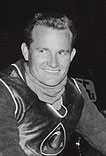 Born in Houston on May 23, 1933, Albert Gunter was the winner of seven AMA Nationals and one of the dominant motorcycle racers of the 1950s and early 1960s. A deep thinker and self-taught mechanic, his influence is still being felt through the many innovations he brought to the sport.
Born in Houston on May 23, 1933, Albert Gunter was the winner of seven AMA Nationals and one of the dominant motorcycle racers of the 1950s and early 1960s. A deep thinker and self-taught mechanic, his influence is still being felt through the many innovations he brought to the sport.
Gunter is credited with inventing, developing, or influencing use of the following: hardened-and-cut tires for better grip on dirt tracks, blended-and-raised valve seats that increased air flow in the cylinder head, pistons and carburetors machined from billet, dynamometers as a race-engine development tool for privateers, hydraulic disc brakes, the full-face safety helmet, and in-helmet radios that enabled riders on the track to talk directly to their pit crew.
Many of Gunter’s ideas were developed and perfected on the BSA Gold Stars on which he scored many of his victories in AMA National competition and at countless regional venues. His tuning talent and knack for trying the unconventional resulted in his extracting more performance from BSA’s famous 500cc single than most others could achieve.
Gunter’s book on engine and chassis tricks for the BSA Gold Star helped school the gang of champions that became known as the “BSA Wrecking Crew." They are AMA Motorcycle Hall of Famers Sammy Tanner, Dick Mann and Neil Keen, as well as Dickie Newell.
Gunter scored his first AMA National win in 1952 at the Shreveport, La., half mile, riding a BSA A7 twin. He quickly built his reputation on the West Coast’s hyper-competitive half-mile dirt-track circuit. California's Ascot Park’s iconic Eight-Mile National fell to Gunter three times, and in 1960 he won the Ascot championship.
An accomplished dirt-track racer, Gunter was also adept at TT courses and counted the Peoria, Ill., TT among his AMA National wins. The determination that made him a star in the dirt also made Gunter a threat on the old beach course in Daytona Beach, Fla. He placed fifth there in 1952, and five years later finished second in the 200-miler.
Remarkably, his 1957 Daytona finish came one day after Gunter and his old friend, Hall of Famer Mann, were jailed. The two BSA riders, who often traveled together on the AMA National circuit, had been stopped and arrested by the local police for testing their race bikes on “Jungle Road,”—the infamous stretch of black asphalt on the outskirts of Daytona Beach used by competitors to dial-in their machines prior to the actual race. To get out of jail in time to make the starting grid of the big race, it took a phone call to BSA’s eastern states president, Hall of Famer Ted Hodgson, who posted bail.
Gunter’s legacy as an inventor and product developer is perhaps as great as his career in the saddle. In the mid-1960s he pushed Bell Auto Parts founder Roy Richter to develop a full-face safety helmet that would provide even more protection than Bell’s game-changing TX500 open-face “jet” helmet had done when it was introduced the previous decade. The resulting Bell Star was the first full-coverage safety helmet. It quickly became the standard for professional racers in every avenue of motorsports, as well as a “must have” for savvy street riders.
The Star significantly influenced helmet design across the safety equipment industry, but Gunter had another idea to go with it. For his own early Star, Gunter installed a microphone and one-way radio transmitter. This was many years before true miniaturization in electronics, but Gunter made it all fit inside the helmet shell. Once the bugs were worked out, Gunter’s racing mechanic, Hardy Allen, would keep his rider apprised of who was gaining on him on the track. The set up was a forerunner of today’s real-time communications (albeit one-way only), but the AMA didn’t share Gunter’s future vision. It considered the radio to be an unfair advantage and banned him from using it.
By the late 1960s, Gunter had retired from racing and was concentrating on turning his innovative ideas into products. One of them was a hydraulic disc brake system that Gunter marketed to road racers as a complete kit. The New Product sections of period bike magazines show Gunter’s kit, which was fitted to professional racer Tony Murphy’s own Norton Manx for testing. It is unknown how many disc-brake kits Gunter sold in the years before the technology became commonplace.
Not completely satisfied unless he was racing motorcycles, Gunter staged a comeback in 1970. He acquired an early Kawasaki H1-R, one of the first of a small batch of the 500cc factory-built triple racers made available to qualified privateers. In practice for the 1970 Daytona 200, the bike’s infamous high-speed wobbles caused the gutsy Gunter to pack up and return home, where he re-engineered much of the machine.
Later he returned to the AMA National dirt-track program, riding a Yamaha twin built by Hall of Famer Shell Thuett. At the San Jose dirt track in California in 1974, Gunter crashed severely and, as a result, was permanently paralyzed from the chest down. Afterwards, the clever innovator and fierce competitor suffered from depression, and in despair took his own life in March 1976.
He was inducted into the AMA Motorcycle Hall of Fame in 1999.